We get a lot of questions asking what is better, the Intel Xeon D-1500 or Xeon E3-1200 V5. We test both platforms and as one might imagine, the answer depends. Each platform occupies part of the market segment aimed at lower power and expansion capabilities than the Intel Xeon E5 series. The approach to each platform is quite different in the way it addresses this space. We build a handy little decision guide to help you decide between the Intel Xeon D-1500 line and the Intel Xeon E3-1200 V5 line. Hopefully this helps answer some frequently asked questions.
The Intel Xeon D-1500 or Intel Xeon E3-1200 V5 Comparison
To frame the decision guide we used three primary discussion vectors: Processing Power, Expansion and Platform Usability. Here is the summary chart of what we have seen:
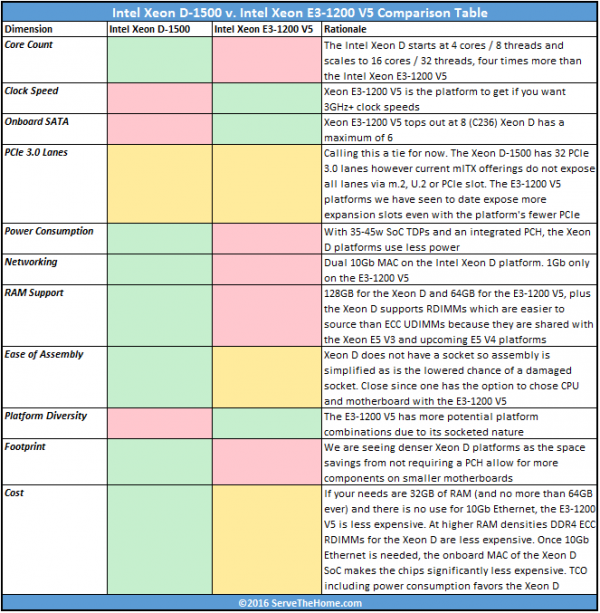
This chart does not mean: get the Xeon D. Instead it is an attempt to show the relative strengths and weaknesses are of each platform. There are many cases where the Intel Xeon E3-1200 V5 is a better choice as there are applications that require platform customization and single threaded speeds. Also, for licensing reasons, the Intel Xeon E3-1200 V5 can be a better choice for per-core licensing models.
Processing Power (Clock Speed and Core Count)
From a compute standpoint, the Xeon D-1500 and Intel Xeon E3-1200 V5 have very different performance goals. The Xeon E3-1200 V5 series is focused on higher clock speeds and does include a newer generation Skylake microarchitecture good for a few percent higher instructions per clock speed. On the opposite side of the spectrum, the Intel Xeon D-1500 starts with a minimum core count that equals the Intel Xeon E3-1200 V5’s maximum. The Xeon D then sacrifices clock speed for more cores while staying within its TDP range.

For those requiring higher clock speeds for database performance or single-threaded application performance, the Intel Xeon E3-1200 V5 is the clear winner. If you need okay single threaded performance but more cores, the Intel Xeon D-1500 series is the way to go. One note here is that unlike previous architectures (e.g. Avoton), the Broadwell-DE core is similar enough to the Intel Xeon E3-1200 V4/ V5 core that the instructions per clock are not far behind, it is simply a clock speed constraint. Four of the eleven models in the Intel Xeon E3-1200 V5 range have onboard GPUs but those are generally used as workstation parts.
Expansion
In terms of expansion, the Xeon E3-1200 V5’s C236 chipset supports up to 8x SATA III 6.0Gbps ports while the Xeon D-1500 SoC is limited to 6x ports. We have seen manufacturers use fewer ports than the platforms would allow but from a raw port perspective the Intel Xeon E3-1200 V5 does have more. In terms of PCIe lanes for expansion cards, the Intel Xeon D-1500 is the clear leader. We see up to 32x PCIe 3.0 lanes available. The Intel Xeon E3-1200 V5 platform did add additional PCIe 3.0 and PCIe 2.0 lanes in the latest revision but for raw PCIe lanes, the Xeon D SoC has more.
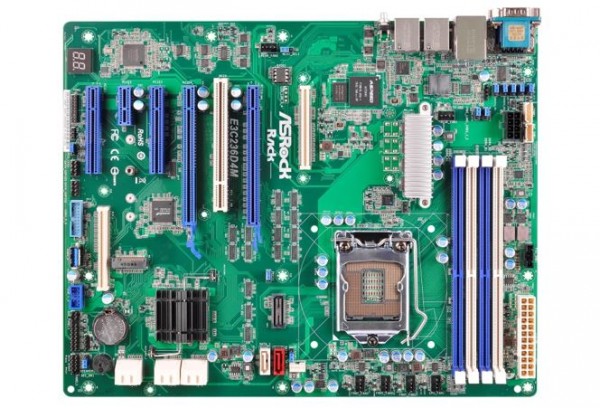
On the networking side, it is not even close. If you need 10Gb Ethernet, the Xeon D has onboard dual 10Gb while the Intel Xeon E3-1200 V5 requires an add-in card that will cost $200-350 new. Since the 10Gb PHY does take up motherboard space and has a component cost, if you do not need 10Gb networking, then the E3-1200 V5 may make more sense.
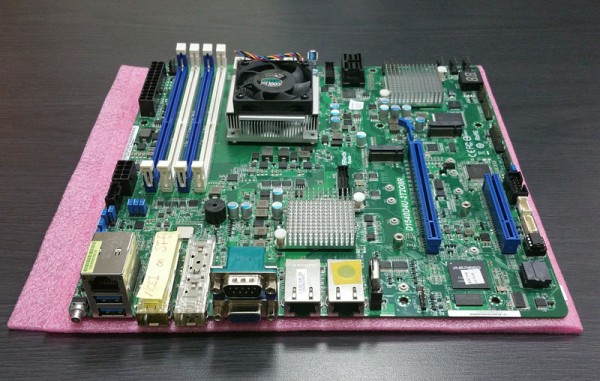
In terms of RAM, the Intel Xeon D-1500 has a much better solution. It accepts DDR4 ECC Registered DIMMs (RDIMMs) just like the Intel Xeon E5 V3 (and subsequent) series as well as Knight’s Landing. The use of RDIMMs makes 128GB possible on the Xeon D-1500 platform where the Intel Xeon E3-1200 V5 platform is limited to 64GB of unbuffered ECC memory (UDIMMs). Likely due to the fact that they have been in mainstream use for some time now, 16GB RDIMMs currently cost less than 16GB UDIMMs so at 64GB it is currently less expensive to fill the Xeon D-1500 memory banks than those of the E3-1200 V5.
Platform Usability
In terms of usability, the fact that the Xeon E3-1200 V5 is a socketed part makes it easy to mix and match with a motherboard that has the corresponding capabilities. One can also upgrade the platform at a later time with a faster processor (or lower power one.) On the other hand, having the socket does mean that there are a few more assembly steps to get correct: removing the socket cover, installing the CPU (without bending pins), latching the CPU in place, applying proper thermal paste, installing a heatsink and potentially a fan. The Intel Xeon D-1500 platforms come with their thermal assemblies already attached. If someone else is assembling your server then these steps are of little consequence. If you are assembling your own server, it is easier to have it pre-installed and never have to worry about a bent pin.
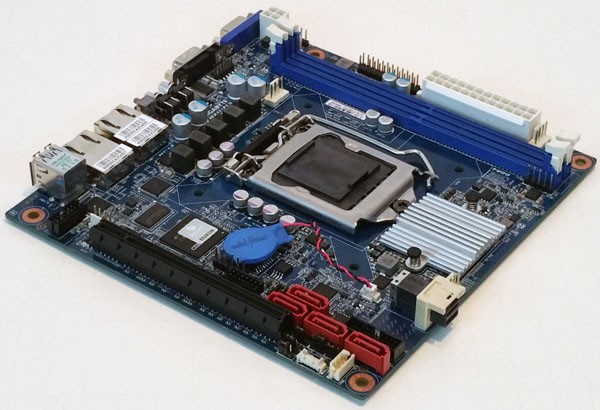
We have found that the Intel Xeon D-1500 mITX platforms are a bit denser in terms of capabilities in the small form factor than their Xeon E3-1200 V5 counterparts. Without a PCH, one can both reduce power consumption as well as reduce footprint on the PCB, leaving room for other components. Overall the current generation of Intel Xeon D-1500 SoC’s has a TDP range of 35-45 watts, and this includes the 10Gb Ethernet MAC as well as the PCH functionality. 8 of the 11 Intel Xeon E3-1200 V5 models have a TDP of 80 watts and three low power models have TDPs ranging from 25-45w.
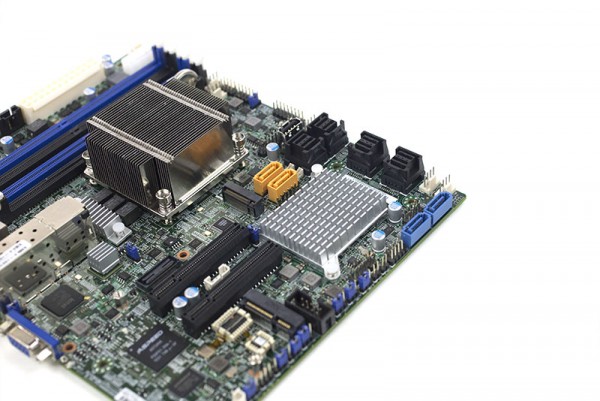
On the cost side the case is not that clear. For example, a base combo E3-1220 V5 (4 cores/ 4 threads) with motherboard will run from about $350 to $450 after normal discounts. The Supermicro X10SDV-4C-TLN2F we reviewed retails for about $470. That Xeon D platform includes dual 10Gbase-T networking which would require an add-on Intel X540-t2 adapter around $300 alone and take up a PCIe expansion slot. Also 4x 16GB ECC DDR4 UDIMMs for the E3-1200 V5 would be around $480 at the time of this writing while 4x 16GB RDIMMs would be about $425 for the Xeon D-1500. At the low end, the Xeon E3-1200 V5 platform is marginally less expensive if you do not need 10Gb Ethernet but much more expensive if you do want 10GbE. Pricing wise we give a small edge to the Intel Xeon D-1500 platform because there is the upside for the 10GbE and lower power consumption likely means one will save any remaining difference on power and cooling within the first few months of operation.
Conclusion
The Intel Xeon D-1500 and Xeon E3-1200 V5 platforms both have merits. Despite being well over a decade into multi-core computing, there is plenty of software that is single thread limited, and other software that is licensed by the number of cores. Likewise, if one needs 7 or 8 SATA III ports, the Intel Xeon E3-1200 V5 can handle that port count without requiring extra disk controllers. For applications such as ZFS storage servers, VM workloads that do not require high clock speeds, many network appliances the Intel Xeon D is an excellent platform.

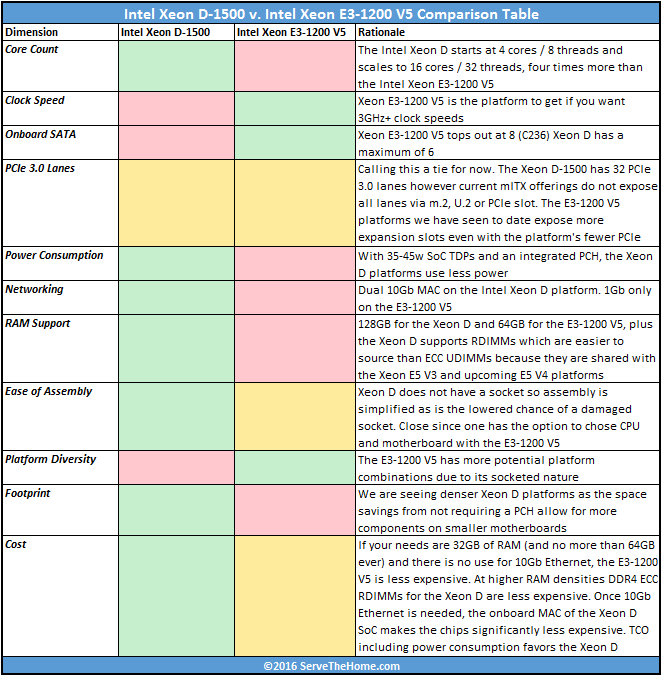



Hi, saturated colors in table would have been more evident, first glance and I had difficulty understanding what light green and pink meant, whilst red and green is clearly distinguishable.
Very nice article. I really love it as I am just building a small Server by myself.
I am curious: What is the end of the last sentence? Is there something missing:
“For applications such as ZFS storage servers, VM workloads that do not require high clock speeds, many network appliances…”
Looks like it got cut off. Should be fixed now.
Great point about using red/ green as colors given some folks have difficulty distinguishing.
THANKS alot
Of course I picked the E3-1260L V5 (45w) over the 1540/1541 – two weeks before you wrote your article! Also, the ECC UDIMM’s mentioned in the article are basically non-existent. I ordered mine and have no idea when they will come in.
I’m sure it’ll be fine – but the XEON D’s are quite package.
The purpose of me new rig this summer, will be to be running a Virtual server for cluster simulations for Hadoop. And the only real comparison to the superb package a D-1540 is, is so far (after many hours in Excel) a dual E5 26xx with either eBay ES cpu’s in the 8-12 core range or legit bought 2618L in both sockets and then measured against TWO D-1540s.
For now I will get a D-1540 and then experiment enough there to get an automated, scripted install-cluster-script solution up and running and then I will deploy as needed to AWS clusters for $12/hr (when someone is footing the bill for my work and dont require on-premise). I just cannot make up my mind if I need the horsepower of the 2618L’s over the 1540 for dev purposes. After all, I could just grab 2x D-1540 if I need more so a difficault situation to gauge. Those darn CPU prices are making life hard.
I was really looking at a socketed solution for a NAS until I read this. Now I’m considering these Xeon SoCs thanks to you. One thing you didn’t mention though is the heat issue with the D-15xx. I read your article on quietly cooling one and was fascinated. They do seem to produce a lot of heat. I’m looking at a Mini-ITX board that comes with a D-1521 and it has a passive heat sink (MBD-X10SDV-4C-TLN2F-O). It’s going into a Chenbro case so I’m going to have to find a way to actively cool it. Fun times ahead!
Great articles and thanks!